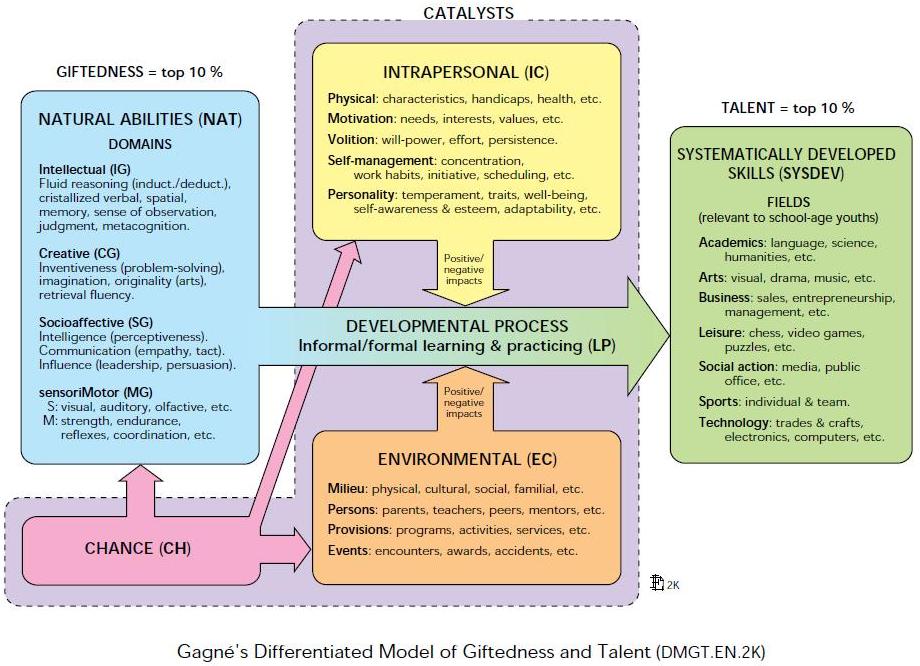Intentional About Potential
If you’ve studied gifted education, you’re probably familiar with Gagné’s Differentiated Model of Giftedness and Talent. Below is a diagram of how his model works. Gagné believes that we are born with gifts, but we have to develop our talents through catalysts. He believed, as we do, that talents don’t happen on their own. A good analogy of a “gift” is an acorn. Some acorns are carried away to fertile soil by some means to grow into a majestic hardwood tree. Others that don’t find favorable conditions rot away and don’t amount to much. By nature, every acorn was meant to grow big and strong into a glorious oak tree, so why is it that only a few of them reach their true potential? According to the model, it’s chance.
To put it simply, our school exists to make your child’s environment more fertile by being intentional. Parents like you are doing an absolutely fantastic job of providing for your gifted child and we are here to support your efforts. We need to provide every morsel of support we can give to our brightest young minds because they truly are the future, and they are worth it!
Take a look at Gagné’s model below. You can click on the image to make it bigger.
Differentiation
Differentiated instruction is a student focused process of adapting curriculum to be sure that students at every learning level can learn effectively. Because we are a gifted-only school, we’re already highly differentiated by definition. There are many levels of giftedness, and a student may not be as gifted in one subject as they are in another, so we schedule our core subjects at the same time throughout the day so students can be accelerated to the level they will learn best at rather than grade skipping all subjects. If a 4th grade student is ready for 8th grade science and math, then they join the 8th grade science and math classes, but they still remain in 4th grade for their other classes.
Intellectual Peer Group
Most students who come to our school are accustomed to being the smartest student in their class. When they enroll in our school, they suddenly find themselves in a peer group that operates at their level and gets them at so many levels. Most gifted students enjoy being in a group where they can truly be themselves and feel somewhat normal.
Highly/Profoundly Gifted
Although extremely rare, we have experience with highly and profoundly gifted students. These are students whose IQ score is 1 in 1,000 all the way up to 1 in millions. Please let us know if you believe your child is highly or profoundly gifted. We have additional resources for you.
Underachievement
There are many valid reasons why gifted students don’t perform at their highest potential all the time. Read Is It a Cheetah? But there is also a legitimate concern of underachievement.
Underachievement is very common among gifted students. Our teachers understand the major causes of underachievement in gifted students and have techniques and resources to help students find motivation. Additionally, our school environment and culture are designed to inspire and motivate students.
Twice-Exceptional
Students are already exceptional by definition of being gifted. Many gifted students have additional exceptionalities such as dyslexia, adhd, autism spectrum, anxiety, a visual or auditory processing disorder, or other diagnosis. Studies have found that around one in six gifted children are twice exceptional. We have experience supporting mild special needs in the gifted population. Some of our teachers are even twice exceptional, so we understand.
Sensory & Accommodations
Because we understand gifted students, we allow many accommodations (as long as they aren’t abused) to help with focus and avoiding getting overwhelmed. Examples include:
- All of our classrooms are sensory friendly. A lot of thought is put into designing each learning space to help students focus, minimize distraction, and inspire students to learn. All of the senses are considered. Gifted students tend to be very sensitive.
- Students are allowed to have a fidget in their hands or doodle if it helps them focus.
- Five minute serenity breaks are allowed and encouraged if a student is beginning to feel overwhelmed. A sensory neutral space will be available to regroup before rejoining the class.
- Some students learn better while sitting on exercise balls. This is encouraged if it helps.
- As long as students are appropriate, we have a flexible dress code. If a student learns better wearing slippers rather than shoes, then that’s fine.
- Instead of having one long recess for elementary students, we have two shorter 15 minute recess breaks, one in the morning and one in the afternoon, for all students in all grades. Our goal is to promote movement and exercise at least once every 90 minutes for older students and at least once every 15 minutes for younger students.

Recommended Links
Fun Challenge | FAQ | Clubs | Faculty and Staff | Employment | Contact Us


